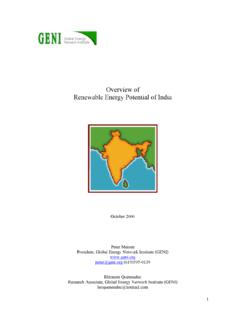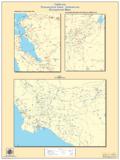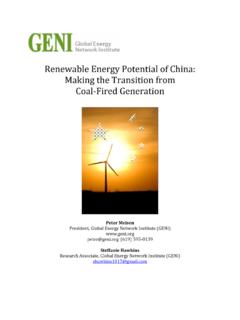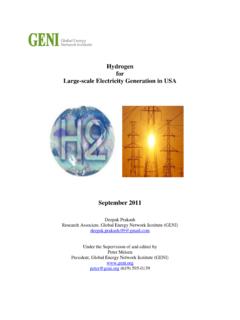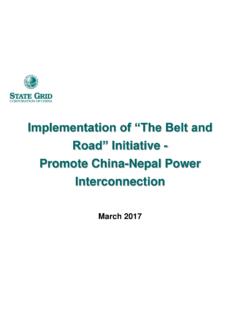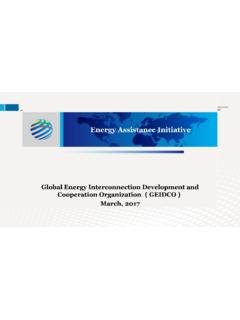Transcription of International Interconnection in East Asia - GENI
1 1 International Interconnection in east asia September, 2013 Daniel Kim Research Associate, global energy Network Institute (GENI) Under the supervision of and edited by Peter Meisen President, global energy Network Institute (GENI) 2 Table of Contents Abstract .. 5 1. Introduction .. 6 2. Proposal .. 7 Benefits of 7 Interconnection Location .. 9 3. Benefits .. 12 Technical .. 12 Economic .. 16 19 Environmental .. 20 4. Issues .. 24 Technical .. 24 Economic .. 24 Environmental .. 25 5. Previous International Interconnections .. 26 ENTSO-E .. 26 North America .. 27 6. Conclusion .. 30 Bibliography .. 31 3 Table of Figures Figure 1: Graph of AC vs. DC Costs .. 7 Figure 2: International Interconnection Proposal .. 9 Figure 3: Interconnection between Japan and Russia .. 9 Figure 4: Interconnection between Japan and South Korea .. 10 Figure 5: Interconnection among China, North Korea, and South Korea.
2 11 Figure 6: Peak loads for China, Japan, South Korea, and Russia in MWh .. 12 Figure 7: Load Graph During 22 Oct 2011 .. 13 Figure 8: Changed Ideal Load Graph .. 13 Figure 9: Land Usage for South Korea .. 14 Figure 10: Korea Topography .. 14 Figure 11: Land Usage for Japan .. 15 Figure 12: Japan Topography .. 15 Figure 13: Korea at Night .. 19 Figure 14: Lifecycle Greenhouse Gas Emissions Intensity of Electricity Generation Methods .. 20 Figure 15: energy Flows of ENTSO-E members and non-members .. 26 Figure 16 & 17: energy Flow in January and February in GWh .. 27 Figure 18: Canada and United States Interconnections .. 28 Table of Tables Table 1: Fuel and Operation 17 Table 2: Water Pollution created by Each Fuel Type .. 22 Table 3: Waste Generation Created by Each Fuel Type .. 23 4 List of Abbreviations Organizations CSP China State Power EBRD European Bank for Reconstruction and Development EIA energy Information Administration ENSTO-E European Network of Transmission System Operators for Electricity JEPX Japan Electric Power Exchange KPX Korea Power Exchange NASA National Aeronautics and Space Administration NEB National energy Board NEI Nuclear energy Institute TSO Transmission System Operator UES Unified energy Systems WNA World Nuclear Association Power Terminology Power is the rate at which energy is generated or consumed.
3 AC Alternating Current DC Direct Current GWh Gigawatt hour. 1 Gigawatt is 1000 Megawatts HVDC High Voltage Direct Current Hz Hertz. km kilometer. 1 kilometer is 1000 meters kWh kilowatt hour. 1 kilowatt is 1000 watts MWh Megawatt hour. 1 Megawatt is 1000 kilowatts TWh Terawatt hour. 1 Terawatt is 1000 Gigawatts 5 Abstract China, Japan, North Korea, South Korea, and Russia are prime candidates for an International Interconnection . Some of these countries face certain problems with their power grids: Japan, North Korea, and South Korea are island grids and also have issues with land use; China cannot keep up with the increasing power demands from its rapid economic growth, and Japan is shifting its generation focus away from nuclear and towards renewables. Being interconnected would solve all of these issues in addition to providing numerous benefits to each country. The purpose of this paper is to show the costs and benefits of an International Interconnection among five countries in east asia : China, Japan, North Korea, South Korea, and Russia.
4 By using high voltage direct current (HVDC) and alternating current (AC) transmission lines, connections will be made across borders over land and underwater. There are many benefits to an International Interconnection , including technical, economic, social, and environmental benefits. Technical benefits include smoother load curves which leads to better efficiency right-of-way issues, and a diverse supply of energy . Economic benefits include increased use of low cost fuels, encouragement of economies of scale, decreased fuel imports, and an indirect benefit to economic growth. Social benefits include an increased quality of life in, but not limited to, education, business, healthcare, and agriculture. Lastly, environmental benefits include increased air and water quality and decreased water and waste use. Successful interconnections between the United States and Canada, along with the connected European grid, shows that an International Interconnection is possible in either a small or continental scale.
5 Despite the technical, economic, and environmental costs of the Interconnection , the benefits of the Interconnection outweigh the costs. 6 1. Introduction This paper is a costs and benefits analysis on an International Interconnection among five countries in east asia : China, Japan, North Korea, South Korea, and Russia. This area is a prime candidate for an Interconnection because of key issues that plague the area, including, but not limited to, energy security and fuel dependency. The Interconnection would not only solve most of these issues, but also provides numerous benefits as well. With successful International interconnections occurring more frequently throughout the world, notably in North America and in Europe, an Interconnection in east asia is not only possible, but also practical. Currently, there are several issues with the five countries. First of all, Japan, North Korea, and South Korea are island grids; they are not connected to any other power grid and are dependent on their own abilities to generate Additionally, because of the size of their countries, Japan and South Korea have trouble finding space for their generation Russia and China are connected, with Russia exporting 2,630 million kWh of electricity to China in However, despite this import, China is still failing to meet the rapidly rising demand of electricity due to lack of transmission efficiency and a shortage of Lastly, Japan has been trying to move away from nuclear and more towards renewable energies, though doing so may cause severe debt 1 Wang, 2000 2 Yun and Zhang, 2005 3 Inter RAO, 2013 4 Bai and Aizhu, 2011 5 Tabuchi, 2012 7 2.
6 Proposal Benefits of HVDC For the International Interconnection , the use of both high voltage direct current (HVDC) transmission lines and alternating current transmission lines between each of the countries is included this proposal. The use of HVDC lines is preferred over the use of alternating current (AC) transmission lines for three main reasons: long distances, asynchronous frequencies, and undersea cables. In certain areas, the distance between transmission lines is extensive. While it is possible to connect two power systems using AC lines, the cost to connect them will be greater than using HVDC. The following figure shows the cost of AC vs. the cost of HVDC. Figure 1: Graph of AC vs. DC Costs Source: ABB As seen in this figure, as the distance between two stations increases, the total cost for both AC and DC lines increases as well. However, DC costs increase at a much slower rate than AC does and therefore, once the line distance hits a certain point, it will be more cost effective to use DC transmission over AC transmission.
7 Another benefit DC transmission lines have over AC transmission is that the lines must traverse bodies of water. Bodies of water separate the countries from each other, specifically, Japan to the others. AC transmission systems underwater reduce the load capability due to high capacitance, which leads to power However, DC transmission systems do not have this problem because the DC lines do not have to deal with frequencies. Additionally, the distance 6 Ragheb, 2012 8 between Japan and the other countries is at least 200 km. Again, while it is possible to connect Japan with the other four countries with AC lines, the cost to do so will be higher than using HVDC. Lastly, the deciding factor as to why HVDC should be used over AC is asynchronous frequencies. The frequencies among the five countries are either 50Hz or Unfortunately, AC currently does not have the technology to connect asynchronous systems and as a result, HVDC will be the best choice to connect countries with differing frequencies.
8 7 McGregor, 2013 9 Interconnection Location For the Interconnection , it is important to utilize a country s power grid to save costs. The following figure displays all of the potential connections among the countries. Figure 2: International Interconnection Proposal The black lines are potential and preferred Interconnection while the grey lines are alternatives. For the Interconnection between Japan and Russia, there are two (2) potential locations to connect the two countries. Figure 3 shows these locations. Figure 3: Interconnection between Japan and Russia 10 One potential path is to go from Hokkaido to Primorsky Krai. The costs will be two (2) converter stations and an extremely long HVDC line going undersea and then back up on land, which will be around 500 600 km. Another option would be from Hokkaido to Sakhalinskaya. However, four (4) converter stations will be needed, two stations between Hokkaido to Sakhalinskaya and two stations between Sakhalinskaya and the rest of Russia.
9 This is because Sakhalinskaya is an island grid and does not connect to the main grid in Russia. Alternatively, an AC transmission system over the water might suffice, depending on weather conditions. For the Interconnection between Japan and South Korea, Figure 4 shows two (2) potential locations to connect the countries together. Figure 4: Interconnection between Japan and South Korea There are two (2) potential ways to connect Japan and South Korea. The first converter station would be located at or around Fukuoka. The second station would either be the current station on Jeju or a new one in Busan. Although there might be some costs averted when connecting to Jeju by utilizing an existing converter station, the distance from Fukuoka to Jeju is about 300 350 km, while the distance between Fukuoka to Busan is only 200 220 km. The differing potential locations among China, North Korea, and South Korea depend on the political situation.
10 Figure 5 shows an example of what these locations might be. 11 Figure 5: Interconnection among China, North Korea, and South Korea There are two (2) possibilities, depending on how cooperative North Korea wants to be. If North Korea is cooperative, an HVDC link from South Korea to North Korea and then from North Korea to Liaoning/Jilin would be ideal. If North Korea is not cooperative, then a longer undersea line from Incheon to Shandong would have to suffice, though it is not ideal due to length (375 400 km) and additional construction of transmission lines across land. 12 3. Benefits There are a number of potential benefits and impacts related to the International Interconnection . These range from technical, economic/financial, social, and lastly, environmental. Technical There are many advantages in the Interconnection from a technical standpoint. One major benefit from the Interconnection comes from the smoothing of peak loads.

